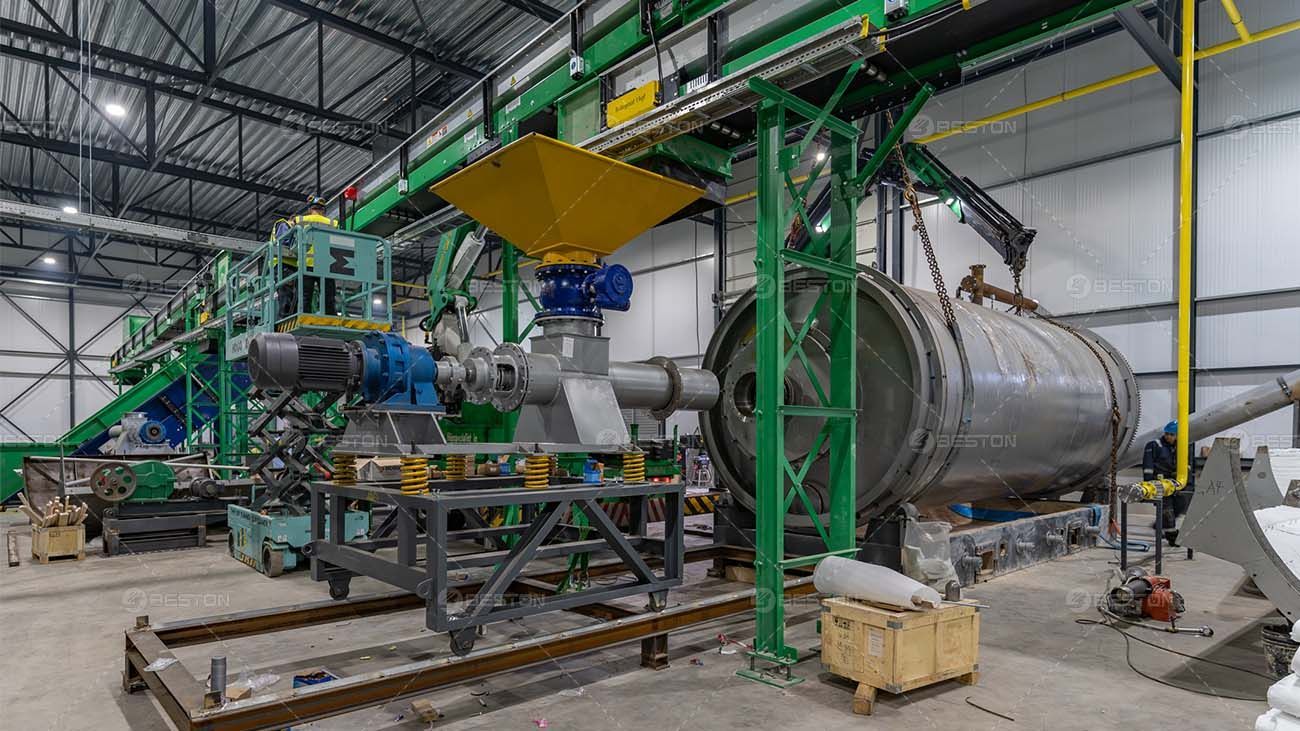
Beston Group
Web: https://bestonmachinery.com/.
Email: sales@bestonmachinery.com
Egg Tray Making Machine
Web: https://bestoneggtraymachine.com/.
Email: sales@bestoneggtraymachine.com.
The Role of Catalytic Treatment in Plastic Pyrolysis
- By Beston Charcoal
- •
- 07 Nov, 2024
- •

Plastic pyrolysis is an increasingly important technology for managing plastic waste by converting it into valuable byproducts like fuel oils, gases, and char. While the pyrolysis process itself is efficient, catalytic treatment plays a critical role in optimizing the outcomes of plastic pyrolysis. The inclusion of a catalyst can significantly enhance the quality of the products and increase the overall efficiency of the plastic pyrolysis machine. This article explores why catalytic treatment is necessary and how it contributes to the process.
1. Enhancement of Product Quality
One of the main reasons for applying catalytic treatment in plastic pyrolysis is to improve the quality of the pyrolysis oil produced. During the pyrolysis process, plastics are thermally decomposed into smaller hydrocarbons. However, without a catalyst, the resulting oil often contains undesirable compounds like heavy fractions, tar, and sulfur. These can negatively impact the usability of the oil, especially for industrial or commercial applications.
Catalysts are employed to break down these heavier compounds into more valuable, lighter hydrocarbons, resulting in a cleaner and higher-quality pyrolysis oil. This is particularly important for the production of high-quality fuels that are suitable for use in engines or industrial machines. The presence of a catalyst improves the yield of light oil, which is easier to refine and can be used directly as an alternative fuel or converted into other chemical products.
2. Increased Pyrolysis Efficiency
Catalysts can also enhance the overall efficiency of the pyrolysis process. Plastic pyrolysis is a complex reaction, and without the right conditions, it may result in lower yields or an incomplete breakdown of plastic waste. Catalysts help to accelerate the reaction rate, making the pyrolysis process faster and more energy-efficient.
In addition to speeding up the decomposition process, catalytic treatment reduces the need for higher temperatures and longer reaction times, which can save energy and operational costs. By lowering the activation energy required for the pyrolysis of plastics, catalysts ensure that the plastic to oil plant operates optimally, without requiring excessive external heating sources.
3. Reduction of Toxic Emissions
Plastic waste is notorious for releasing harmful gases when pyrolyzed without proper treatment. Some plastics contain chlorine, which, if not managed properly, can lead to the production of toxic compounds like dioxins and furans. Catalytic treatment plays a key role in mitigating these toxic emissions.
Certain catalysts help to neutralize harmful gases like hydrogen chloride (HCl), converting them into less hazardous compounds. In some cases, catalytic systems may also reduce the formation of tar and other particulate matter, which can clog up equipment and require additional processing. The reduction of such pollutants makes the process safer, more environmentally friendly, and compliant with regulatory standards.
4. Improved Selectivity of Byproducts
In plastic pyrolysis, the byproducts generated—gaseous, liquid, and solid—vary depending on the feedstock and the operating conditions. Catalytic treatment can help fine-tune the selectivity of these byproducts. Depending on the catalyst used, the process can be tailored to produce a higher proportion of specific products.
For example, if the goal is to maximize the production of liquid fuels, a specific catalyst can be chosen that favors the production of more volatile compounds, which can then be refined into high-quality fuel oils. Alternatively, if gas production is the focus, a catalyst can be used to promote the formation of gaseous products like methane, ethane, or propane. By adjusting the catalytic conditions, the plastic pyrolysis machine can be optimized to meet specific output requirements, providing a more controlled and targeted production process.
5. Cost-Effectiveness and Sustainability
Although the use of a catalyst may add to the initial cost of the plastic pyrolysis machine, the long-term benefits far outweigh the investment. The improved product quality, higher yields, and energy efficiency that catalytic treatment offers lead to reduced operational costs. Furthermore, the reduction in harmful emissions and the ability to produce cleaner, more refined products make the process more sustainable.
Catalytic pyrolysis also aligns with the growing trend towards sustainable waste management. By improving the breakdown of plastic waste into valuable fuel products, the process becomes more viable for large-scale adoption. The use of catalysts ensures that the pyrolysis process is both economically and environmentally sustainable, making it a key technology for tackling the global plastic waste crisis.
Conclusion
Catalytic treatment is a crucial step in optimizing the performance of plastic pyrolysis. It enhances the quality of the pyrolysis oil, increases the efficiency of the process, reduces toxic emissions, and improves the selectivity of byproducts. Moreover, it contributes to the cost-effectiveness and sustainability of the process, positioning plastic pyrolysis as a promising solution for plastic waste management. By incorporating catalytic systems into the plastic pyrolysis machine, manufacturers can significantly improve the viability and scalability of this important waste-to-energy technology.
https://bestonmachinery.com/charcoal-making-machine/
https://bestonmachinery.com/biochar-production-equipment/
https://bestonmachinery.com/charcoal-making-machine/sawdust/
https://bestonmachinery.com/charcoal-making-machine/palm-kernel-shell/
https://bestonmachinery.com/biochar-production-equipment/reactor/
https://bestonmachinery.com/charcoal-making-machine/videos/
https://bestonmachinery.com/charcoal-making-machine/faqs/
https://bestonmachinery.com/biochar-production-equipment/reactor/
https://bestonmachinery.com/biomass-pyrolysis-plant/
https://bestonmachinery.com/charcoal-making-machine/components/
https://bestonmachinery.com/charcoal-making-machine/price/
https://bestonmachinery.com/charcoal-production-machine/
https://bestonmachinery.com/charcoal-making-machine/coconut-shell/
https://bestonmachinery.com/charcoal-making-machine/rice-hull/
https://bestonmachinery.com/wood-pyrolysis-plant/
https://bestonmachinery.com/charcoal-making-machine/jute-stick/
https://bestonmachinery.com/charcoal-making-machine/bamboo/
https://bestonmachinery.com/charcoal-making-machine/sugarcane-bagasse/
https://bestonmachinery.com/coconut-shell-charcoal-making-machine-price/
https://bestonmachinery.com/shisha-charcoal-making-machine/
https://bestonmachinery.com/charcoal-making-machine/wood/
https://bestonmachinery.com/carbonization-machine/
https://bestonmachinery.com/charcoal-manufacturing-machine/
https://bestonmachinery.com/biochar-production-equipment/mobile/
https://bestonmachinery.com/products/
https://bestonmachinery.com/straw-charcoal-machine/
https://bestonmachinery.com/solutions/
https://bestonmachinery.com/biochar-machine-for-sale/
https://bestonmachinery.com/biomass-carbonization-machine/
https://bestonmachinery.com/carbonization-furnace/
https://bestonmachinery.com/carbon-sequestration-and-emission-reduction-solution/
https://bestonmachinery.com/soil-remediation-and-improvement-solution/
https://bestonmachinery.com/biomass-charcoal-as-fuel-alternative-for-industries/
https://bestonmachinery.com/pulp-moulding-products/
https://bestonmachinery.com/charcoal-making-machine-for-sale/
https://bestonmachinery.com/bbq-charcoal-making-machine/
https://bestonmachinery.com/charcoal-making-machine/continuous/
https://bestonmachinery.com/biochar-pyrolysis-equipment/
https://bestonmachinery.com/biomass-charcoal-making-machine/
https://bestonmachinery.com/sewage-sludge-carbonization-plant/
https://bestonmachinery.com/charcoal-making-machine/small/
https://bestonmachinery.com/charcoal-making-machine-in-cameroon/
https://bestonmachinery.com/charcoal-making-machine-in-cote-divoire/
https://bestonmachinery.com/charcoal-making-machine-in-morocco/
https://bestonmachinery.com/charcoal-making-machine-in-kenya/
https://bestonmachinery.com/charcoal-making-machine-in-south-korea/
https://bestonmachinery.com/charcoal-making-machine-in-thailand/
https://bestonmachinery.com/charcoal-making-machine-in-ghana/
https://bestonmachinery.com/charcoal-making-machine-in-the-philippines/
https://bestonmachinery.com/charcoal-making-machine-in-sri-lanka/
https://bestonmachinery.com/charcoal-making-machine-in-turkey/
https://bestonmachinery.com/charcoal-making-machine-in-the-united-states/
https://bestonmachinery.com/pyrolysis-plant/
https://bestonmachinery.com/pyrolysis-plant/continuous/
https://bestonmachinery.com/pyrolysis-plant/reactor/
https://bestonmachinery.com/tyre-pyrolysis-plant/
https://bestonmachinery.com/plastic-to-fuel-machine/
https://bestonmachinery.com/pyrolysis-plant/faqs/
https://bestonmachinery.com/pyrolysis-plant/mini-skid-mounted/
https://bestonmachinery.com/pyrolysis-plant/manufacturer/
https://bestonmachinery.com/tyre-pyrolysis-plant/project-report/
https://bestonmachinery.com/pyrolysis-plant/cost/
https://bestonmachinery.com/pyrolysis-plant/videos/
https://bestonmachinery.com/oil-sludge-pyrolysis-plant/
https://bestonmachinery.com/pyrolysis-plant/mobile/
https://bestonmachinery.com/tyre-to-oil-plant/
https://bestonmachinery.com/tyre-to-oil-plant/
https://bestonmachinery.com/rubber-pyrolysis-plant/
https://bestonmachinery.com/pyrolysis-plant/technology/
https://bestonmachinery.com/pyrolysis-plant/process/
https://bestonmachinery.com/pyrolysis-plant/small/
https://bestonmachinery.com/tyre-to-fuel-recycling-plant/
https://bestonmachinery.com/thermal-desorption-unit/
https://bestonmachinery.com/pyrolysis-plant/components/
https://bestonmachinery.com/pyrolysis-plant/semi-continuous/
https://bestonmachinery.com/pyrolysis-system/
https://bestonmachinery.com/plastic-pyrolysis-plant/
https://bestonmachinery.com/pyrolysis-plant-in-morocco/
https://bestonmachinery.com/pyrolysis-machine-in-egypt/ https://bestonmachinery.com/pyrolysis-plant-in-zimbabwe/ https://bestonmachinery.com/pyrolysis-plant-in-australia/ https://bestonmachinery.com/pyrolysis-plant/uk/ https://bestonmachinery.com/pyrolysis-plant/the-philippines/
https://bestonmachinery.com/pyrolysis-plant/nigeria/
https://bestonmachinery.com/pyrolysis-plant/malaysia/ https://bestonmachinery.com/pyrolysis-plant-in-canada/ https://bestonmachinery.com/pyrolysis-plant-in-china/ https://bestonmachinery.com/tyre-pyrolysis-plant-in-uae/
https://bestonmachinery.com/pyrolysis-plant-in-morocco/
https://bestonmachinery.com/pyrolysis-machine-in-egypt/
https://bestonmachinery.com/pyrolysis-plant-in-zimbabwe/
https://bestonmachinery.com/pyrolysis-plant-in-australia/
https://bestonmachinery.com/pyrolysis-plant/uk/
https://bestonmachinery.com/pyrolysis-plant/the-philippines/
https://bestonmachinery.com/pyrolysis-plant/nigeria/
https://bestonmachinery.com/pyrolysis-plant/malaysia/
https://bestonmachinery.com/pyrolysis-plant-in-canada/
https://bestonmachinery.com/pyrolysis-plant-in-china/
https://bestonmachinery.com/tyre-pyrolysis-plant-in-uae/
https://bestonmachinery.com/pyrolysis-plant-in-pakistan/
https://bestonmachinery.com/pyrolysis-plant-in-botswana/
https://bestonmachinery.com/pyrolysis-plant-in-indonesia/
https://bestonmachinery.com/pyrolysis-oil-as-fuel-alternative-for-industries/
https://bestonmachinery.com/oil-contaminated-soil-remediation-solution/
https://bestonmachinery.com/tyre-shredder/
https://bestonmachinery.com/industrial-packaging-machine/
https://bestonmachinery.com/egg-tray-making-machine-in-saudi-arabia/
https://bestonmachinery.com/egg-tray-making-machine-in-morocco/
https://bestonmachinery.com/egg-tray-making-machine-in-russia/
https://bestonmachinery.com/egg-tray-making-machine/philippines/
https://bestonmachinery.com/egg-tray-making-machine/china/
https://bestonmachinery.com/egg-tray-making-machine/price-in-india/
https://bestonmachinery.com/egg-tray-making-machine/turkey/
https://bestonmachinery.com/egg-tray-making-machine/nigeria/
https://bestonmachinery.com/egg-tray-making-machine/price/
https://bestonmachinery.com/apple-tray-making-machine/
https://bestonmachinery.com/egg-tray-making-machine/videos/
https://bestonmachinery.com/egg-tray-making-machine/dryer/
https://bestonmachinery.com/turnkey-project/
https://bestonmachinery.com/egg-tray-making-machine/project-report/
https://bestonmachinery.com/egg-tray-packing-machine/
https://bestonmachinery.com/paper-tray-making-machine/
https://bestonmachinery.com/egg-tray-making-machine/manual/
https://bestonmachinery.com/pulp-molding-machine/manufacturers/
https://bestonmachinery.com/egg-crate-making-machine/
https://bestonmachinery.com/egg-tray-manufacturing-machine/
https://bestonmachinery.com/egg-tray-making-machine/for-sale/
https://bestonmachinery.com/egg-carton-machine/
https://bestonmachinery.com/egg-tray-making-machine-in-egypt/
https://bestonmachinery.com/egg-tray-making-machine-in-iraq/
https://bestonmachinery.com/egg-tray-making-machine/india/
https://bestonmachinery.com/egg-tray-making-machine/pakistan/
https://bestonmachinery.com/egg-tray-making-machine/philippines/
https://bestonmachinery.com/egg-tray-making-machine/china/
https://bestonmachinery.com/egg-tray-making-machine/price-in-india/
https://bestonmachinery.com/egg-tray-making-machine/turkey/
https://bestonmachinery.com/egg-tray-making-machine/nigeria/
https://bestonmachinery.com/egg-box-machine/
https://bestonmachinery.com/egg-tray-making-machine/800-1000/
https://bestonmachinery.com/egg-tray-making-machine/1200-1500/
https://bestonmachinery.com/egg-tray-making-machine/2000pcs/
https://bestonmachinery.com/egg-tray-making-machine/2200-2500/
https://bestonmachinery.com/egg-tray-making-machine/3500-4500/
https://bestonmachinery.com/egg-tray-making-machine/5000-5500/